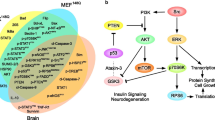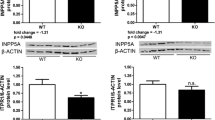Abstract
Spinocerebellar ataxia type 3/Machado–Joseph disease (SCA3/MJD) is a late-onset neurodegenerative disorder caused by the expansion of a polyglutamine tract within the gene product, ataxin-3. Microarray analysis revealed a dramatic differential expression of carbonic anhydrase-related protein XI (CA-RPXI/CA11) in the presence or absence of mutant ataxin-3. Therefore, we examined the expression and distribution of all three CA-RPs (CA8, 10, and 11) in human neuronal cells that stably express mutant ataxin-3. Compared with the cells containing normal ataxin-3, protein expression of CA8 and CA11 is significantly increased in human neuroblastoma cells harboring mutant ataxin-3. Semi-quantitative RT-PCR demonstrated that all three CA-RPs exhibited significantly higher transcript levels in neuronal cells expressing mutant ataxin-3. Interestingly, CA11 is distributed not only in the cytoplasm but also within the nuclei of the stably transfected mutant cells when compared with the sole cytoplasmic distribution in cells containing normal ataxin-3. In addition, results from transient transfection assays in SK-N-SH and Neuro2a (N2a) cells also confirmed the nuclear localization of CA11 in the presence of truncated ataxin-3. Most importantly, immunohistochemical staining of the MJD transgenic mouse and post-mortem MJD human brain also revealed that CA11 is highly expressed in both cytoplasm and nuclei of the brain cells. Recruitment of CA11 into nuclear inclusions containing mutant ataxin-3 revealed a possible correlation between CA11 and disease progression. Although the exact function of CA-RPs is still undefined in the central nervous system, our findings suggest that CA-RPs, especially CA11, may play specific roles in the pathogenesis of Machado–Joseph disease.







Similar content being viewed by others
References
Kawaguchi Y, Okamoto T, Taniwaki M, Aizawa M, Inoue M, Katayama S, et al. CAG expansions in a novel gene for Machado–Joseph disease at chromosome 14q32.1. Nat Genet. 1994;8(3):221–8. PubMed PMID: 7874163. eng.
Costa MD, Paulson HL. Toward understanding Machado–Joseph disease. Prog Neurobiol. 2011; 97:239–57. PubMed PMID: 22133674. Pubmed Central PMCID: PMC3306771. Eng.
Yuasa T, Ohama E, Harayama H, Yamada M, Kawase Y, Wakabayashi M, et al. Joseph’s disease: clinical and pathological studies in a Japanese family. Ann Neurol. 1986;19(2):152–7. PubMed PMID: 3963757. eng.
Burnett B, Li F, Pittman RN. The polyglutamine neurodegenerative protein ataxin-3 binds polyubiquitylated proteins and has ubiquitin protease activity. Hum Mol Genet. 2003;12(23):3195–205. PubMed PMID: 14559776. eng.
Chai Y, Berke SS, Cohen RE, Paulson HL. Poly-ubiquitin binding by the polyglutamine disease protein ataxin-3 links its normal function to protein surveillance pathways. J Biol Chem. 2004;279(5):3605–11. PubMed PMID: 14602712. eng.
Donaldson KM, Li W, Ching KA, Batalov S, Tsai CC, Joazeiro CA. Ubiquitin-mediated sequestration of normal cellular proteins into polyglutamine aggregates. Proc Natl Acad Sci USA. 2003;100(15):8892–7. PubMed PMID: 12857950. Pubmed Central PMCID: PMC166409. eng.
Doss-Pepe EW, Stenroos ES, Johnson WG, Madura K. Ataxin-3 interactions with rad23 and valosin-containing protein and its associations with ubiquitin chains and the proteasome are consistent with a role in ubiquitin-mediated proteolysis. Mol Cell Biol. 2003;23(18):6469–83. PubMed PMID: 12944474. Pubmed Central PMCID: PMC193705. eng.
Scheel H, Tomiuk S, Hofmann K. Elucidation of ataxin-3 and ataxin-7 function by integrative bioinformatics. Hum Mol Genet. 2003;12(21):2845–52. PubMed PMID: 12944423. eng.
Warrick JM, Morabito LM, Bilen J, Gordesky-Gold B, Faust LZ, Paulson HL, et al. Ataxin-3 suppresses polyglutamine neurodegeneration in Drosophila by a ubiquitin-associated mechanism. Mol Cell. 2005;18(1):37–48. PubMed PMID: 15808507. eng.
Sherman MY, Goldberg AL. Cellular defenses against unfolded proteins: a cell biologist thinks about neurodegenerative diseases. Neuron. 2001;29(1):15–32. PubMed PMID: 11182078. eng.
Haacke A, Broadley SA, Boteva R, Tzvetkov N, Hartl FU, Breuer P. Proteolytic cleavage of polyglutamine-expanded ataxin-3 is critical for aggregation and sequestration of non-expanded ataxin-3. Hum Mol Genet. 2006;15(4):555–68. PubMed PMID: 16407371. eng.
Breuer P, Haacke A, Evert BO, Wüllner U. Nuclear aggregation of polyglutamine-expanded ataxin-3: fragments escape the cytoplasmic quality control. J Biol Chem. 2010;285(9):6532–7. PubMed PMID: 20064935. Pubmed Central PMCID: PMC2825449. eng.
Paulson HL, Bonini NM, Roth KA. Polyglutamine disease and neuronal cell death. Proc Natl Acad Sci USA. 2000;97(24):12957–8. PubMed PMID: 11058149. Pubmed Central PMCID: PMC34075. eng.
McCampbell A, Fischbeck KH. Polyglutamine and CBP: fatal attraction? Nat Med. 2001;7(5):528–30. PubMed PMID: 11329046. eng.
Nucifora FC, Sasaki M, Peters MF, Huang H, Cooper JK, Yamada M, et al. Interference by huntingtin and atrophin-1 with CBP-mediated transcription leading to cellular toxicity. Science. 2001;291(5512):2423–8. PubMed PMID: 11264541. eng.
Dunah AW, Jeong H, Griffin A, Kim YM, Standaert DG, Hersch SM, et al. Sp1 and TAFII130 transcriptional activity disrupted in early Huntington’s disease. Science. 2002;296(5576):2238–43. PubMed PMID: 11988536. eng.
Li F, Macfarlan T, Pittman RN, Chakravarti D. Ataxin-3 is a histone-binding protein with two independent transcriptional corepressor activities. J Biol Chem. 2002;277(47):45004–12. PubMed PMID: 12297501. eng.
Wen FC, Li YH, Tsai HF, Lin CH, Li C, Liu CS, et al. Down-regulation of heat shock protein 27 in neuronal cells and non-neuronal cells expressing mutant ataxin-3. FEBS Lett. 2003;546(2–3):307–14. PubMed PMID: 12832059. eng.
Evert BO, Vogt IR, Vieira-Saecker AM, Ozimek L, de Vos RA, Brunt ER, et al. Gene expression profiling in ataxin-3 expressing cell lines reveals distinct effects of normal and mutant ataxin-3. J Neuropathol Exp Neurol. 2003;62(10):1006–18. PubMed PMID: 14575237. eng.
Chang WH, Cemal CK, Hsu YH, Kuo CL, Nukina N, Chang MH, et al. Dynamic expression of Hsp27 in the presence of mutant ataxin-3. Biochem Biophys Res Commun. 2005;336(1):258–67. PubMed PMID: 16126176. eng.
Reina CP, Zhong X, Pittman RN. Proteotoxic stress increases nuclear localization of ataxin-3. Hum Mol Genet. 2010;19(2):235–49. PubMed PMID: 19843543. Pubmed Central PMCID: PMC2796889. eng.
Koch P, Breuer P, Peitz M, Jungverdorben J, Kesavan J, Poppe D, et al. Excitation-induced ataxin-3 aggregation in neurons from patients with Machado–Joseph disease. Nature. 2011;480(7378):543–6. PubMed PMID: 22113611. eng.
Paulson HL, Perez MK, Trottier Y, Trojanowski JQ, Subramony SH, Das SS, et al. Intranuclear inclusions of expanded polyglutamine protein in spinocerebellar ataxia type 3. Neuron. 1997;19(2):333–44. PubMed PMID: 9292723. eng.
Schmidt T, Landwehrmeyer GB, Schmitt I, Trottier Y, Auburger G, Laccone F, et al. An isoform of ataxin-3 accumulates in the nucleus of neuronal cells in affected brain regions of SCA3 patients. Brain Pathol. 1998;8(4):669–79. PubMed PMID: 9804376. eng.
Ross CA, Poirier MA. Opinion: what is the role of protein aggregation in neurodegeneration? Nat Rev Mol Cell Biol. 2005;6(11):891–8. PubMed PMID: 16167052. eng.
Arrasate M, Mitra S, Schweitzer ES, Segal MR, Finkbeiner S. Inclusion body formation reduces levels of mutant huntingtin and the risk of neuronal death. Nature. 2004;431(7010):805–10. PubMed PMID: 15483602. eng.
Rochet JC. Novel therapeutic strategies for the treatment of protein-misfolding diseases. Expert Rev Mol Med. 2007;9(17):1–34. PubMed PMID: 17597554. eng.
Kvam E, Nannenga BL, Wang MS, Jia Z, Sierks MR, Messer A. Conformational targeting of fibrillar polyglutamine proteins in live cells escalates aggregation and cytotoxicity. PLoS One. 2009;4(5):e5727. PubMed PMID: 19492089. Pubmed Central PMCID: PMC2683928. eng.
Sly WS, Hu PY. Human carbonic anhydrases and carbonic anhydrase deficiencies. Annu Rev Biochem. 1995;64:375–401. PubMed PMID: 7574487. eng.
Hewett-Emmett D. Evolution and distribution of the carbonic anhydrase gene families. EXS. 2000;90:29–76. PubMed PMID: 11268522. eng.
Lehtonen J, Shen B, Vihinen M, Casini A, Scozzafava A, Supuran CT, et al. Characterization of CA XIII, a novel member of the carbonic anhydrase isozyme family. J Biol Chem. 2004;279(4):2719–27. PubMed PMID: 14600151. eng.
Tashian RE, Hewett-Emmett D, Carter N, Bergenhem NC. Carbonic anhydrase (CA)-related proteins (CA-RPs), and transmembrane proteins with CA or CA-RP domains. EXS. 2000;90:105–20. PubMed PMID: 11268511. eng.
Hewett-Emmett D, Tashian RE. Functional diversity, conservation, and convergence in the evolution of the alpha-, beta-, and gamma-carbonic anhydrase gene families. Mol Phylogenet Evol. 1996;5(1):50–77. PubMed PMID: 8673298. eng.
Taniuchi K, Nishimori I, Takeuchi T, Ohtsuki Y, Onishi S. cDNA cloning and developmental expression of murine carbonic anhydrase-related proteins VIII, X, and XI. Brain Res Mol Brain Res. 2002;109(1–2):207–15. PubMed PMID: 12531530. eng.
Taniuchi K, Nishimori I, Takeuchi T, Fujikawa-Adachi K, Ohtsuki Y, Onishi S. Developmental expression of carbonic anhydrase-related proteins VIII, X, and XI in the human brain. Neuroscience. 2002;112(1):93–9. PubMed PMID: 12044474. eng.
Jiao Y, Yan J, Zhao Y, Donahue LR, Beamer WG, Li X, et al. Carbonic anhydrase-related protein VIII deficiency is associated with a distinctive lifelong gait disorder in waddles mice. Genetics. 2005;171(3):1239–46. PubMed PMID: 16118194. Pubmed Central PMCID: PMC1456827. eng.
Türkmen S, Guo G, Garshasbi M, Hoffmann K, Alshalah AJ, Mischung C, et al. CA8 mutations cause a novel syndrome characterized by ataxia and mild mental retardation with predisposition to quadrupedal gait. PLoS Genet. 2009;5(5):e1000487. PubMed PMID: 19461874. Pubmed Central PMCID: PMC2677160. eng.
Kaya N, Aldhalaan H, Al-Younes B, Colak D, Shuaib T, Al-Mohaileb F, et al. Phenotypical spectrum of cerebellar ataxia associated with a novel mutation in the CA8 gene, encoding carbonic anhydrase (CA) VIII. Am J Med Genet B Neuropsychiatr Genet. 2011;156B(7):826–34. PubMed PMID: 21812104. eng.
Chang WH, Tien CL, Chen TJ, Nukina N, Hsieh M. Decreased protein synthesis of Hsp27 associated with cellular toxicity in a cell model of Machado–Joseph disease. Neurosci Lett. 2009;454(2):152–6. PubMed PMID: 19429074. eng.
Cemal CK, Carroll CJ, Lawrence L, Lowrie MB, Ruddle P, Al-Mahdawi S, et al. YAC transgenic mice carrying pathological alleles of the MJD1 locus exhibit a mild and slowly progressive cerebellar deficit. Hum Mol Genet. 2002;11(9):1075–94. PubMed PMID: 11978767. eng.
Cairns J, Qin S, Philp R, Tan YH, Guy GR. Dephosphorylation of the small heat shock protein Hsp27 in vivo by protein phosphatase 2A. J Biol Chem. 1994;269(12):9176–83. PubMed PMID: 7510704. eng.
Hirota J, Ando H, Hamada K, Mikoshiba K. Carbonic anhydrase-related protein is a novel binding protein for inositol 1,4,5-trisphosphate receptor type 1. Biochem J. 2003;372(Pt 2):435–41. PubMed PMID: 12611586. Pubmed Central PMCID: PMC1223404. eng.
Chen X, Tang TS, Tu H, Nelson O, Pook M, Hammer R, et al. Deranged calcium signaling and neurodegeneration in spinocerebellar ataxia type 3. J Neurosci. 2008;28(48):12713–24. PubMed PMID: 19036964. Pubmed Central PMCID: PMC2663415. eng.
Acknowledgments
We thank Drs. Akira Kakizuka and Henry Paulson for MJD plasmids, Drs. Cemal Cemal and Yung-Hsiang Hsu for brain tissues, Dr. Shin-Lan Hsu for SK-N-SH cells, Dr. Chi-Min Shih for his assessment and interpretation of immunostaining data, Benjamin Hsieh for editing the manuscript, and Tang-Hao Chi and Tzu-Kai Wang for assistance of figure preparation. This work was supported by grants from the National Science Council of the Republic of China (NSC-91-2320-B-040-038; NSC-93-2311-B-029-009; NSC-97-2311-B-029-001-MY3).
Conflict of Interest
The authors declare that there is no conflict of interest with respect to financial or personal relationships with organizations that may have influence on this work.
Author information
Authors and Affiliations
Corresponding author
Rights and permissions
About this article
Cite this article
Hsieh, M., Chang, WH., Hsu, CF. et al. Altered Expression of Carbonic Anhydrase-Related Protein XI in Neuronal Cells Expressing Mutant Ataxin-3. Cerebellum 12, 338–349 (2013). https://doi.org/10.1007/s12311-012-0430-2
Published:
Issue Date:
DOI: https://doi.org/10.1007/s12311-012-0430-2




